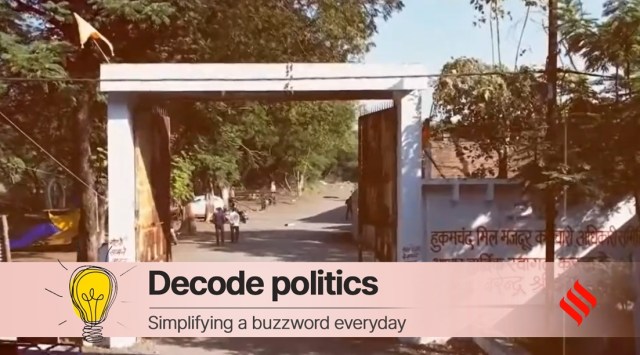Decode Politics: A defunct mill, a payout, and PM Modi — the Hukumchand Mill case
The mill in Indore abruptly shut down in 1992 due to financial troubles, leaving around 5,000 workers without a job and significantly affecting the local economy.
 n 1992, the mill abruptly shut down due to financial troubles. This left around 5,000 workers jobless and without their salaries. (X/ @PIB_India)
n 1992, the mill abruptly shut down due to financial troubles. This left around 5,000 workers jobless and without their salaries. (X/ @PIB_India)Prime Minister Narendra Modi handed over a cheque of about Rs 224 crore of dues to the workers of Hukumchand Mill in Indore at the “Mazdooron Ka Hit Mazdooron ko Samarpit” event on Monday. Why did the PM personally disburse the dues and what are the political implications of the move?
What is the Hukumchand mill case?
The mill was spread across 17.52 hectares granted by the British colonial government in 1923. High-quality cotton fabric was produced in the mill and exported to foreign countries. About 7,000 labourers and staff officers were employed in the mill at one point. In 1992, the mill abruptly shut down due to financial troubles. This left around 5,000 workers jobless and without their salaries.
What impact did the mill’s closure have?
It significantly affected Indore’s local economy. Thousands of families faced financial hardships, affecting local businesses and the overall economic climate. The prolonged struggle for dues led to protests, hunger strikes, and other forms of public demonstrations. This created social unrest. Furthermore, the resentment found its way into regional politics with politicians across both the BJP and the Congress promising to resolve the dispute and introduce laws to protect labour rights during assembly elections.
How was the case finally resolved?
The Madhya Pradesh High Court appointed the official liquidator in 2001 and the Debt Recovery Authority (DRT) was ordered to auction and was instructed to settle the liabilities. Several attempts were made to auction the loan by the Debt Recovery Authority (DRT) but without success.
The state government had been working on a settlement plan since 2018 and the final shape it took after consulting a wide range of stakeholders was “paying all dues upfront, taking possession of the mill land, and developing it into a residential and commercial space”, officials said.
Following negotiations between various departments over the years, the High Court on October 20, 2023, accepted a “compromise amount of Rs.435.89 crore given to pay within two weeks”. Of this, Rs 229 crore was approved for the mill workers.
Why did Modi personally distribute the dues?
BJP leaders said the PM’s outreach was in line with the continuing strategy of “Modi guarantee” employed effectively in the recently held assembly elections, where Modi personally made promises to different voter groups, often addressing local issues and aspirations. In the coming Lok Sabha polls, Modi guarantees will be central to the BJP’s campaign. In Madhya Pradesh, there is a feeling among a section of BJP leaders that the state government’s welfare push, including the Ladli Behana Yojana that entails a monthly stipend of Rs 1,250, had a major impact in the elections in which the party won 163 seats.
“PM Modi directly associated himself with resolving a long-standing labour dispute. This will further bolster his image as a champion of the working class. This resonates with a large voter base, potentially strengthening our party’s support among labourers and unions. Workers, especially those in the textile industry, form a significant voting bloc in the Indore region. Modi ji has been paying special focus on his four ‘jatis’ of poor, youth, women, and farmers,” said a BJP leader.



- 01
- 02
- 03
- 04
- 05




























